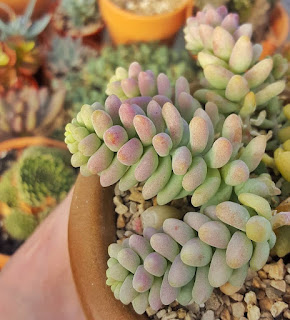Pachyphytum Compactum: How to take care of 'Little Jewel' plant
Pachyphytum Compactum, also known as the "Little Jewel," is one of those succulents that makes you stop and go, "Wow, is that even real?" With its chunky, opalescent leaves that seem to shimmer with a spectrum of colors from pinks to blues to silvers, it's like a living gemstone. But don't let its delicate looks deceive you; this plant is as hardy as they come, making it a perfect gem for both seasoned succulent collectors and beginners. Ready to add some sparkle to your succulent collection? Let’s dive into how to care for and propagate your very own Little Jewel. If you don't own a Compactum but would like to you can find one here.
The TLC Your Pachyphytum Compactum Deserves
1. Basking in the Glow:
Sunlight is to Pachyphytum Compactum what spinach is to Popeye. It thrives in bright, indirect light, which brings out the vibrant colors in its leaves. Too much direct sunlight can cause sunburn, while too little light will make it stretch out in search of the sun. A spot near a window that gets plenty of light but is shielded from the harsh midday rays is ideal.
2. The Thirst Quench Schedule:
Watering your Little Jewel is like walking a tightrope – it needs just enough, but not too much. Wait until the soil is completely dry before watering again. This usually means watering every 2-3 weeks in the growing season (spring and summer) and cutting back in the winter. Overwatering is the fastest way to say goodbye to your succulent, so when in doubt, it’s better to underwater. If you want to be extra sure you can buy a water meter to take away any guesswork.
3. Home Sweet Home:
A well-draining soil mix is non-negotiable for Pachyphytum Compactum. A pre-made cactus or succulent mix usually does the trick, but you can also make your own by mixing potting soil with sand or perlite. Ensure the pot has drainage holes to let any excess water escape.
4. The Comfort Zone:
Pachyphytum Compactum is not a fan of the cold. It prefers temperatures between 60-80°F (15-27°C) and needs to be protected from frost. If you live in a cooler climate, it’s best to grow your Little Jewel in a container that can be moved indoors during cold snaps.
Propagating the Jewel: Multiplying Your Treasures
1. Leaf Cuttings – The Simple Way:
Propagating Pachyphytum Compactum can feel like magic. Gently twist off a healthy leaf, making sure it comes off cleanly without leaving any part behind. Let the leaf dry for a few days until the cut end callouses over, then place it on top of moist succulent soil. In no time, you'll see baby plants beginning to form. Keep the soil slightly moist but not wet.
2. Stem Cuttings – A Speedy Alternative:
For a quicker start, take a stem cutting using a clean, sharp knife. Cut a healthy stem, let it dry and callous over for a few days, then plant it in moist succulent soil. Water sparingly until you see new growth, which means the cutting has successfully rooted.
Jewels in Your Crown: Extra Care Tips
- Feeding: During the growing season (spring and autumn), you can feed your Compactum with a diluted low-nitrogen succulent fertilizer to encourage growth.
- Pest Patrol: Keep an eye out for common succulent pests such as aphids and mealybugs. If you spot any, treat your plant with a gentle insecticide or remove pests manually with a cotton swab dipped in rubbing alcohol. There are lots of little places for bugs to hide on Compactum so try to be extra vigilant, it is best to catch pests early before they get out of control.
- Grooming: Remove dead or dying leaves to keep your plant healthy and prevent any potential pest or disease issues. A pair of long tweezers can help to carefully remove dead leaves from any cracks.
Caring for and propagating Pachyphytum Compactum is a wonderfully rewarding experience. Not only do you get to enjoy the beauty of this unique succulent, but you can also share the love by propagating new plants to give to friends and family. With a bit of care and attention, your Little Jewel will keep shining bright in your succulent collection. Happy gardening!

.png)






